interview by Romina Ciulli and Carole Dazzi
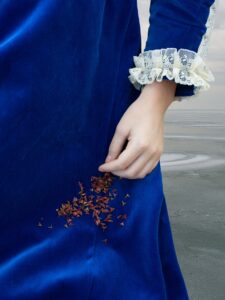
The works of the writer and photographer Alessandra Baldoni are characterized by a sense of uniqueness and restless disenchantment, rendered through an intimate and personal approach. Her images speak to us of themes related to memory, awareness, feelings, and are true stories of the soul, made up of bonds that intertwine and emotions that reveal themselves. Starting from a conceptual context made of words, the artist in fact brings out a powerful and poignant flow of photo-stories, in which everyone can recognize themselves, everyone can feel their own experience and essence. It is the art of storytelling, of creating universes where everything remains and never stops echoing.
All aspects we find in her works, from C’era un volto and Le cose che vedi, from Ti rubo gli occhi and I need protection, to projects such as Salva con nome, Pigre divinità e pigra sorte, Atlas and Corpo Celeste. Let’s talk with the artist.
In your photographs you use a creative process which, starting from the word, stages stories made up of people and very distinct existential moments, which seem to come from a conscious need to tell, if not to remember. Can you tell us about how your work starts?
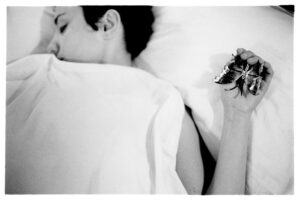
My emotions are always hanging on the line of literature. The word is the spark, it shines shimmering in the darkness of the days, it is the fire in the distance igniting the imagination by outlining the contours of things. I myself have always written, the word is a medicine and a spell, the most powerful I know. It makes things happen, similar to magic. I like to say that I write little scripts for a shoot. But whether the words are mine or those of others, true or invented, it doesn’t matter much as long as they bring wonder, they are slashes capable of opening cracks in the opaque surface of the world. Existing means to tell and to be told, it has always been like this. The epic, the myths, the fairy tales, poems, novels… even our incessant contemporary sending of messages is a saying “I am here, I exist”. To tell a story is to choose which of the facts that constantly happen has a meaning, it is taking something from the indifferent passage of time to embroider, so that it becomes a bearer of meaning.
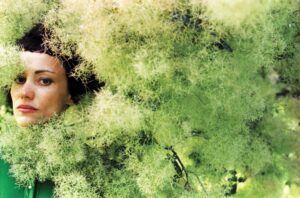
All my art chases that embroidery, the plot (not surprisingly). And I would like my images to rise from the words, like sudden apparitions. Epiphanies inlaid with gold. In my work I look for the entirety of words, I look for everything we neglect, leave behind bent and plagued by the noise surrounding us. I am looking for the words that take us back to our fragility, to the mortality that reminds us of the accuracy of the present, that shows us the ruin, the slender existence hidden behind glazes and polishing. Words where abandonment, wound, disturbance often resonates. Well, I love uncertain linguistic spaces, deviations, submerged streams of meaning. “If I wrote it was out of thought/ because I had life in my thoughs”, Antonella Anedda.
In your works we perceive a sort of cinematic staging, or rather cinematic script, in which the shot represents the final phase of an intimate and in-depth preparatory process. Can you explain this aspect?
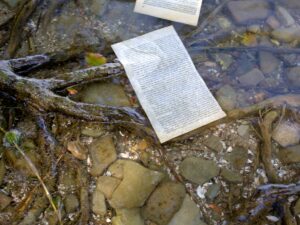
Much of my work deals with a profound solitude that resembles immersion. I spend my days studying, searching, traversing poetry, literature, cinema, sixteenth-century painting. Like a diver lowered into the abyss, I walk hesitatingly, sometimes with my breath broken by fatigue, in search of treasures. The ideas, the trigger, can come from anywhere. Everything originates from desire. A push, a vertigo. A map to decipher. Something is calling, I couldn’t say otherwise. And study and discipline are essential so that the idea of work takes shape and substance. Everything is thought out, everything is decided, marked, noted. When I get to the shot, the execution is always quick: I’ve had the image in my head for months, I know very well what I want. My sets are dioramas of my imagination.
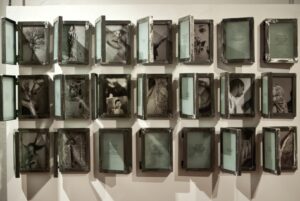
Here however, in this part of the creative process after the work has taken on consistency and is structured, I am no longer alone but in a certain sense I have an ever-changing team at my side who helps and supports me. I wouldn’t be who I am if people hadn’t posed for me in the most absurd ways, if they hadn’t helped me find objects, clothes, shoot on ice or in flames, access otherwise impossible places. I have to say that the moment on set is always exciting: sometimes even when there are many of us, there is an almost religious silence. Sometimes instead there is music and confusion. And it’s amazing how people get into art, how suddenly nothing matters like what we’re doing. The heat, the cold, the difficulty doesn’t matter. We are all focused on staging something that previously existed only in my head, a personal ghost of mine that suddenly appears to everyone.
In “Le mie parole sono balocchi” and “Stamattina nello specchio”, taken from the project “C’era un volto”, the real world is enriched with symbolic and enigmatic elements, such as animal masks, or objects that evoke the fantastic, thus creating alienating moments of reflection. Can you tell us about it?
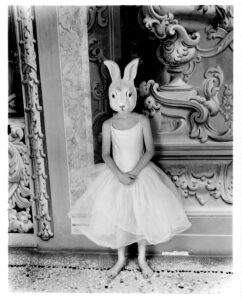
I’m always looking for cracks, small distortions of reality. I look for the ripples, the fractures in the world. I like to think that the shadows of the night sometimes stretch into unsuspected corners of reality. Perhaps for something to touch us we must feel the uncanny of it, there must be a subtle sense of danger. I like metamorphoses, transformations like in fairy tales, like in the sacred. It is necessary to cross existential and semantic realms to evolve. The fairy tale par excellence is the discovered place, the place where everything is possible, for better or for worse, and events are always tests to be overcome with creative acts. It is the place of initiation. I love what puts me in difficulty, which is not immediate, that forces me to look to the side, out of the corner of my eye, as if to look for presences that would otherwise remain invisible, leaning against the walls.
In your photographs emerges forcefully, often through the use of black and white, a sensation of melancholy suspension, of indefinite and captivating mystery. Like for example in your work “Le cose che vedi”, where the female figures, mostly dressed in red, tell a fairy-tale imagery that becomes real, because it comes from the depths of ourselves. How does symbolism influence your work?
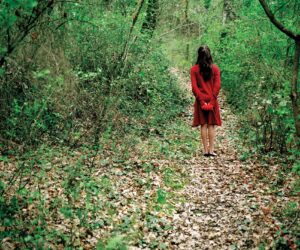
I am looking for symbols that cross the eyes and soul of the beholder. Symbols that speak even if not questioned. May they whisper ancient truths. A bit like in recurring dreams, there are enigmas that appear within us and that take us to another, very distant time, where everyday rules don’t work. I have worked a lot on the fairy tale, on the power it conceals and like Cristina Campo, I believe it is very close to poetry. Riddles, rebuses. Traps. Wolves. Little girls who get lost in the woods dressed in red and who resonate in us. Red is a color that followed me for years, a color I fell into every time. The color of blood, of risk, of danger. The most brazenly vivid color. Sometimes it is necessary to cross certain inhospitable and wild places. It is necessary to get lost. The symbols are crossroads, they are half-way indications, partially erased maps. We recognize them but not entirely. Something is familiar, known, but there is also something extremely foreign, not tamed, not pronounced that pushes us to search, pushes us into an extreme territory where every step is risk, mystery. “and today I listen / to the sound in / your vertebrae, / the internal space / to / words, / fireflies of / this darkness / of mine.” Elisa Biagini.
Another fundamental aspect emerging from your works is that of the word. The stories, poems, or diaries, as in the installation “Ti rubo gli occhi“, or the phrases set in the caskets of “I need protection“, allow the spectator to concretely “touch” emotions, feelings, thoughts, and to make them live an experience that they consciously discover is their own. Can you tell us about these projects and how important the written approach was for their realization?
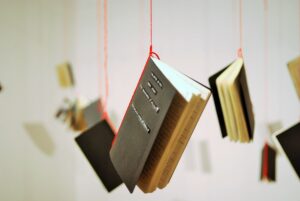
I agree with what you said. Both projects were designed to be touched and read, to be physically approached because words are the matter. Do you remember the pages of a, b, c and so on when we learned to write in first grade? Pages and pages of letters, at first uncertain then gradually more certain, with a heavy line… pages like embroidered sheets. A trousseau, to go to life as a bride. “Ti rubo gli occhi” is a project that I have carried out for years, sending a diary to be filled, in a month, first to people I knew and then to anyone who contacted me to have one. On the first page I put a photo, always different. The starting point, north on the map. But then everyone was free to move from my starting point and build a journey in the direction of my mentioned route or, even more interestingly, to deliberately get lost. It was an archive of existences. I collected about a hundred of them, all magnificent (written, drawn, sewn, torn, embroidered, full of photos or things), and when I displayed them hanging from red threads, visitors to the exhibition spent whole days reading because it is certainly irresistible being able to look out from the balcony of the body onto the lives of others.
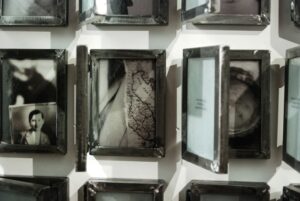
Instead, “I Need Protection” was born after I was invited by the Sansepolcro Glass Biennale to produce a themed work. After studying some processes, and not wanting to produce a purely decorative work, I began to reflect on glass and its meanings. I immediately thought of Snow White, fairy tales always come to my aid, that she sleeps in a glass coffin after falling asleep due to the poisoned apple. And then I thought about the relics of saints in glass cases, about the objects in museums. To the glass that protects but is fragile at the same time. To glass which becomes dangerous if it breaks… This is how the idea of iron and glass caskets was born. I asked 21 people to write to me their greatest desire or greatest fear so that I could cherish them, take care of them. The caskets display those verses, those words frontally, engraved ina glass that veils and hides the interior. Then opening them, a photo/metaphor under a glass with an aquatic and nebulous effect like the unconscious stages that desire or that fear. A sentimental census, a taxonomic collection of emotions. In both projects the word is the hinge that holds everything together.
For “Salva con nome” you were inspired by literature, creating a work dedicated to female writers. While for “Pigre divinità e pigra sorte” dialogues with the masterpieces of the National Gallery of Umbria, transforming the works into suggestive and personal narrative diptychs. Can you tell us how these projects were born?
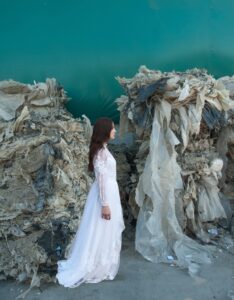
“Salva con nome” is a tribute work to some of the writers and poets (such as Amelia Rosselli, Ingeborg Bachmann, Antonia Pozzi, Emily Bronte, Virginia Woolf, Louise Gluck) who filled my eyes and my heart with incandescent images and visions. Those women who fought to have a place, a room all to themselves, and with great difficulty tried to make us hear their voice in an exclusively male-sounding universe. Saved by their name, by their name and their identity. Saved despite the violent attempt to silence them, despite the strong aggression of the world which often made them feel lost, abandoned, led them to suicide. I felt the need to thank them. I felt the need to tell some of their verses through images, I wanted the power, the talent, the furious grace of which they were capable to be clear.
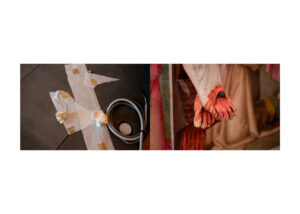
Pigre divinità e pigra sorte”, a title taken from a collection of poems by Patrizia Cavalli, is a work born from an extraordinary circumstance. At the time the director of the Galleria Nazionale Umbra, Marco Pierini, allowed me to enter the gallery during the works for its reorganization. I had access at a very delicate moment, in the middle of a construction site where things were still in an uncertain phase: many works had been moved and detached from the walls that had kept them for decades but everything still had to find a new place and new form. I witnessed a metamorphosis, I saw eternity offering me its side. I had the idea of juxtaposing details of the works (which seemed to stare at me, wondering about their fate) with details of the works. The gold of the frescoes and the bubble wrap, angels’wings and nails and stucco, electrical wires and saints’ feet… An unforgettable moment, seeing works of the great classical tradition within a building site and putting the eternal and the ephemeral into dialogue. I don’t think I will ever be able to forget that August afternoon when alone I walked through the rooms of the gallery one last time before their incredible rearrangement. Everything was fragile and uncertain, everything was suspended as if it had to be spoken into existence again.
Another important project is the exhibition entitled “Corpo Celeste”, that was born from a workshop during which you confronted a group of teenagers and their expectations, their desires, and fears. Can you tell us what emerged from this work and why you chose this title?
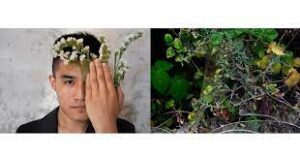
“Corpo Celeste” is the title of a small collection of essays by Anna Maria Ortese. I read, on Doppiozero, an article by Chandra Livia Candiani who talked about her book and in the words she used I found the idea for my project. “Don’t tell yourself the story as the tyrants of thought want, don’t put on a mask and let it become our skin. Learn to stay hidden. Aside. Go back to playing. Making harmless madness a legitimate resource. Stay still and quiet, watch and listen. Stop scaring all other beings and humans who don’t toe the line. Stop talking only to those who echo us. Let ourselves be seen as ugly as we are, as cruel as we are, out of trust in transformation and in fundamental goodness, the one that doesn’t do it on purpose. Don’t make excuses, but stop and mend.” After two years of a pandemic, of isolated bodies detached and punished and of faces halved out of necessity, I needed to rediscover the entirety of the portrait. I missed the splendor of the faces, the wonder they represent. I felt that the stories were interrupted, broken like a book without a half. CasermArcheologica in Sansepolcro is a place of urban regeneration and enchantment.
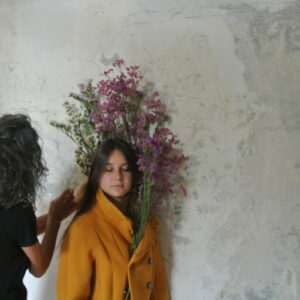
For ten years I have been doing creative disobedience workshops with high school kids in its spaces. I was invited to do a residency where I would portray all the kids, teenagers responding to our call. Forty showed up. I am very interested in this age group, an incandescent, extreme moment, full of unmeasured but still intact and martial emotions. I built small sets with things brought by me and them, I listened to them and again I asked for fears and desires from these kids who had been prisoners of a pandemic for two years. I felt the fear, the sense of death, the overwhelming fragility of their stories but also the wish, the desire to talk about the future again after a painful present made up of daily death bulletins. The result was a luminous Atlas made up of unruly souls in which I put their faces in dialogue with the territory and some significant places: details of paintings from the Civic Museum, the Resistance Museum Archive, the Diocesan Archive, the Aboca Museum, and of CasermArcheologica itself. “Corpo Celeste” has become an exhibition and a small book as blue as grace.
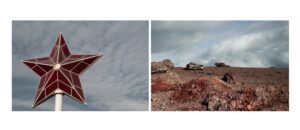
Instead, it is from the Atlas of images entitled Mnemosybe by the art historian Aby Warburg that your “Atlas” takes inspiration: images made of assonances, links, references between past and present, exteriority and interiority. In this way is created a constant dialogue made of memories, which opens up to new universes and new questions. How important is memory for your work?
The meeting with Aby Warburg’s Atlas Mnemosyne was decisive for me. The idea of the permanence of images in our culture, which are reactivated each time, of the return of specific gestures and iconographies has changed my way of seeing. I realize that for me building sequences in diptychs and triptychs according to recurrences and rhymes, assonances and discordances made of similar lines and colors, visual rhymes in meanings, has become a method, a way to search for a mathematics of beauty, a secret fractal that makes the world resonate. I can no longer see the images individually, when I get close to them they catch fire, they take on the shape of a mystery.

They are disturbances, combinations that transcend space and time. Some images are taken from ancient art, others concern the landscape or animals and minerals. And then there are the portraits which are the most specifically constructed part of the work. Everything is sought, chased, leaves an enigma beside it. Memory is telling about the oldest burials and understanding why certain names still resonate, it is going back but reconfiguring things, mixing them with the present. Memory is creative, unstable, wonderfully lying. It’s something that always changes. Images work if they are short circuits, if they offer handles and open doors onto scenarios where the past moves and becomes destiny in the present.
Are there any artist who inspire you or who continue to influence you?
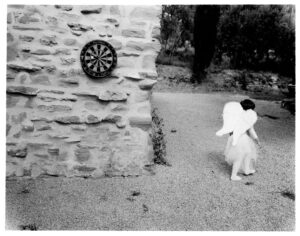
There are a lot of them actually. It would be difficult to make a list also because they change and take on different importance depending on the moment. Let’s say that there are writers and poets who are pieces of my heart, such as Emily Dickinson, Antonella Anedda or Jolanda Insana. To remain in the purely artistic context, I would tell you that a personal heroine of mine is Sophie Calle. I love all of her work and the play component that often accompanies her projects. And then, Christian Boltanski. But also Diane Arbus, Duane Michals and, an artist I have followed and admired for years, Alessandra Spranzi. Once again it is the story calling me, it is the artists who give voice to the things that happen.